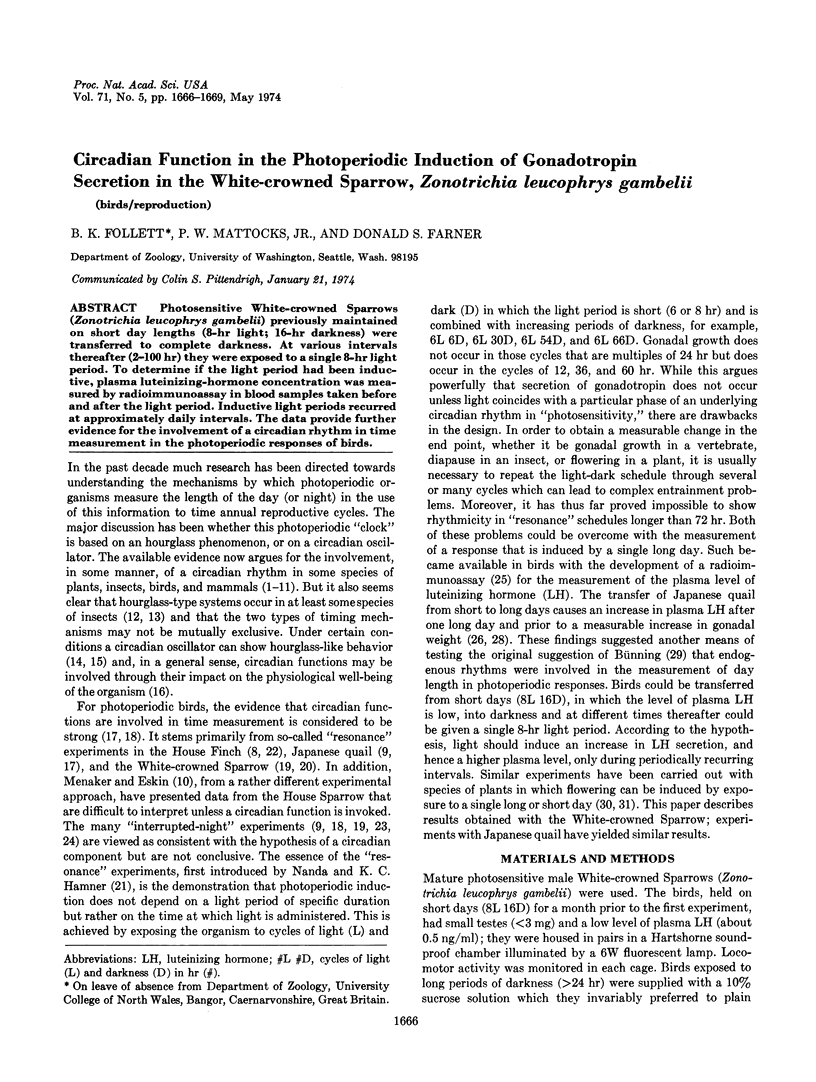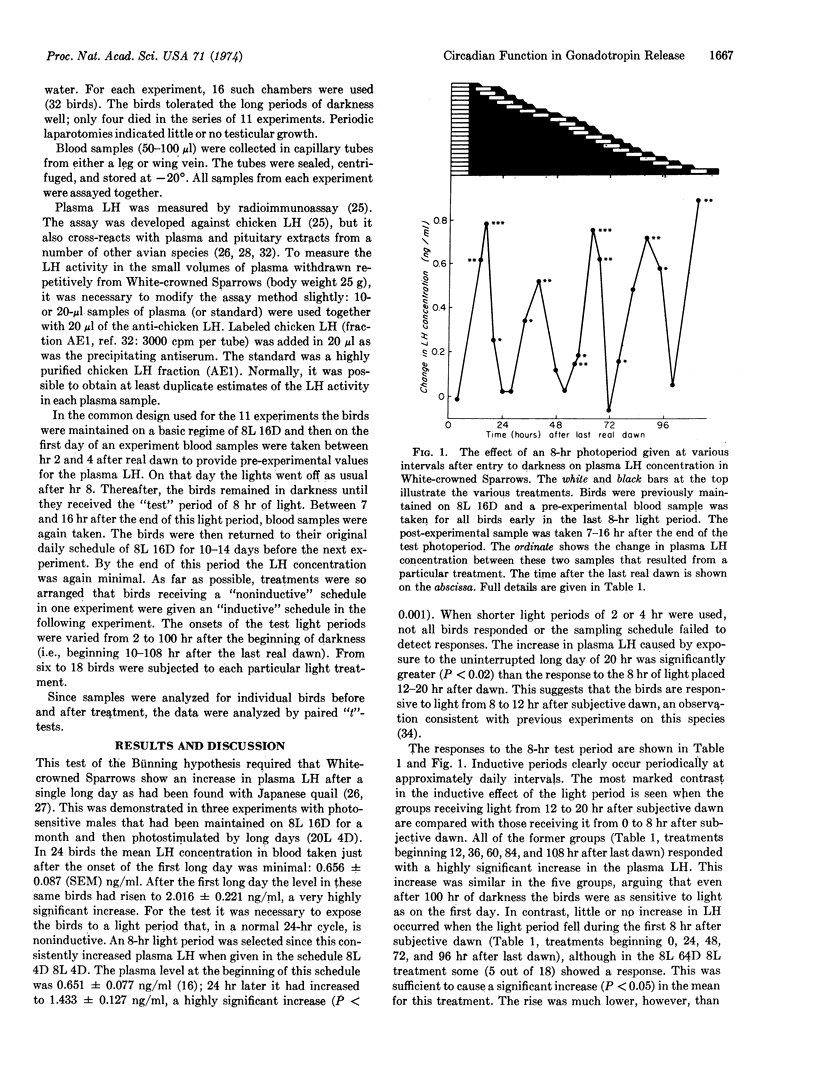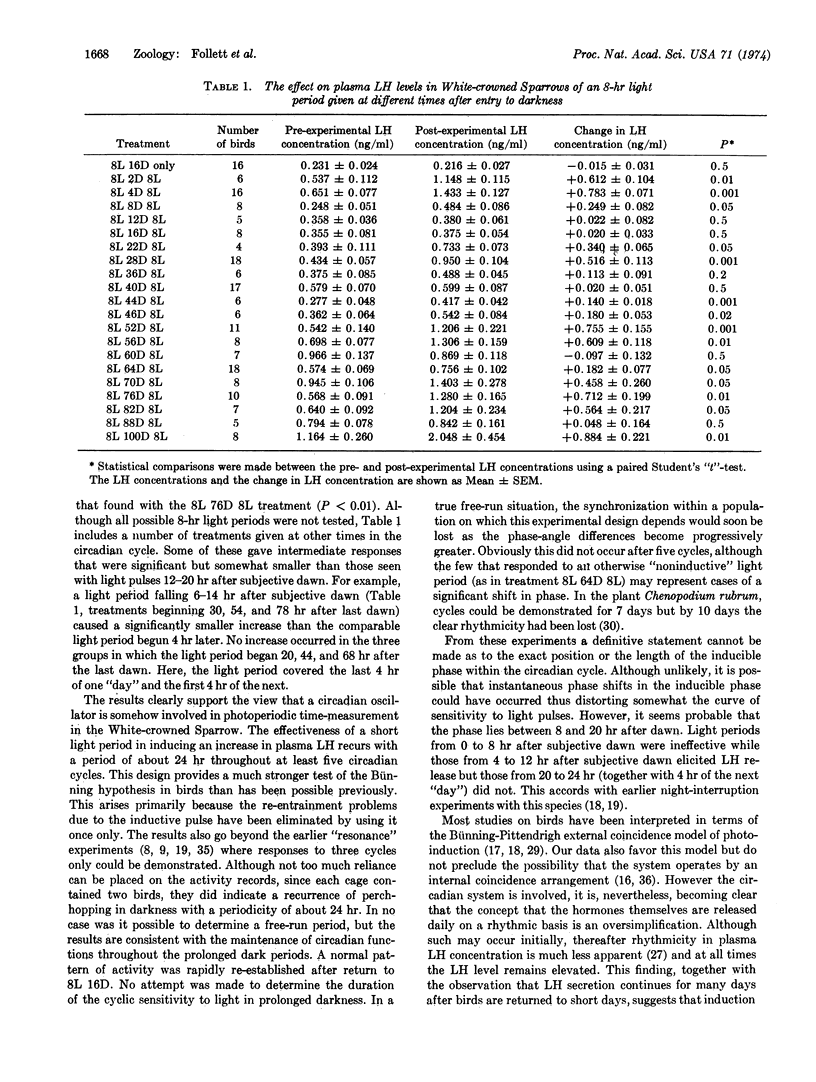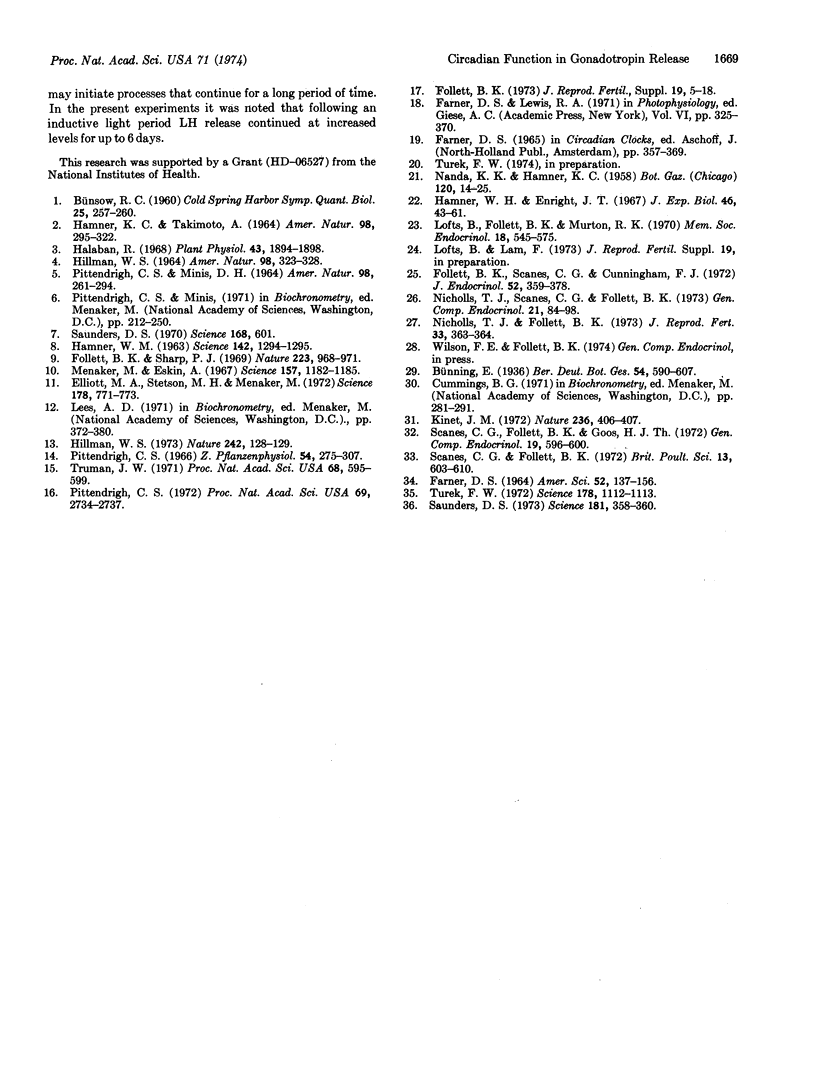Abstract
Photosensitive White-crowned Sparrows (Zonotrichia leucophrys gambelii) previously maintained on short day lengths (8-hr light; 16-hr darkness) were transferred to complete darkness. At various intervals thereafter (2-100 hr) they were exposed to a single 8-hr light period. To determine if the light period had been inductive, plasma luteinizing-hormone concentration was measured by radioimmunoassay in blood samples taken before and after the light period. Inductive light periods recurred at approximately daily intervals. The data provide further evidence for the involvement of a circadian rhythm in time measurement in the photoperiodic responses of birds.
Keywords: birds, reproduction
Full text
PDF



Selected References
These references are in PubMed. This may not be the complete list of references from this article.
- Elliott J. A., Stetson M. H., Menaker M. Regulation of testis function in golden hamsters: a circadian clock measures photoperiodic time. Science. 1972 Nov 17;178(4062):771–773. doi: 10.1126/science.178.4062.771. [DOI] [PubMed] [Google Scholar]
- Follett B. K. Circadian rhythms and photoperiodic time measurement in birds. J Reprod Fertil Suppl. 1973 Dec;19:5–18. [PubMed] [Google Scholar]
- Follett B. K., Scanes C. G., Cunningham F. J. A radioimmunoassay for avian luteinizing hormone. J Endocrinol. 1972 Feb;52(2):359–378. [PubMed] [Google Scholar]
- Follett B. K., Sharp P. J. Circadian rhythmicity in photoperiodically induced gonadotrophin release and gonadal growth in the quail. Nature. 1969 Aug 30;223(5209):968–971. doi: 10.1038/223968b0. [DOI] [PubMed] [Google Scholar]
- Halaban R. The flowering response of coleus in relation to photoperiod and the circadian rhythm of leaf movement. Plant Physiol. 1968 Dec;43(12):1894–1898. doi: 10.1104/pp.43.12.1894. [DOI] [PMC free article] [PubMed] [Google Scholar]
- Hammer W. M., Enright J. T. Relationships between photoperiodism and circadian rhythms of activity in the house finch. J Exp Biol. 1967 Feb;46(1):43–61. doi: 10.1242/jeb.46.1.43. [DOI] [PubMed] [Google Scholar]
- Hamner W. M. Diurnal Rhythm and Photoperiodism in Testicular Recrudescence of the House Finch. Science. 1963 Dec 6;142(3597):1294–1295. doi: 10.1126/science.142.3597.1294. [DOI] [PubMed] [Google Scholar]
- Menaker M., Eskin A. Circadian clock in photoperiodic time measurement: a test of the Bünning hypothesis. Science. 1967 Sep 8;157(3793):1182–1185. doi: 10.1126/science.157.3793.1182. [DOI] [PubMed] [Google Scholar]
- Nicholls T. J., Follett B. K. Daily rhythms of LH release in quail when gonadal development is initiated by long daylengths. J Reprod Fertil. 1973 May;33(2):363–364. doi: 10.1530/jrf.0.0330363. [DOI] [PubMed] [Google Scholar]
- Nicholls T. J., Scanes C. G., Follett B. K. Plasma and pituitary luteinizing hormone in Japanese quail during photoperiodically induced gonadal growth and regression. Gen Comp Endocrinol. 1973 Aug;21(1):84–98. doi: 10.1016/0016-6480(73)90158-5. [DOI] [PubMed] [Google Scholar]
- Pittendrigh C. S. Circadian surfaces and the diversity of possible roles of circadian organization in photoperiodic induction. Proc Natl Acad Sci U S A. 1972 Sep;69(9):2734–2737. doi: 10.1073/pnas.69.9.2734. [DOI] [PMC free article] [PubMed] [Google Scholar]
- Saunders D. S. Circadian clock in insect photoperiodism. Science. 1970 May 1;168(3931):601–603. doi: 10.1126/science.168.3931.601. [DOI] [PubMed] [Google Scholar]
- Saunders D. S. Thermoperiodic control of diapause in an insect: theory of internal coincidence. Science. 1973 Jul 27;181(4097):358–360. doi: 10.1126/science.181.4097.358. [DOI] [PubMed] [Google Scholar]
- Scanes C. G., Follett B. K. Fractionation and assay of chicken pituitary hormones. Br Poult Sci. 1972 Nov;13(6):603–610. doi: 10.1080/00071667208415987. [DOI] [PubMed] [Google Scholar]
- Scanes C. G., Follett B. K., Goos H. J. Cross-reaction in a chicken LH radioimmunoassay with plasma and pituitary extracts form various species. Gen Comp Endocrinol. 1972 Dec;19(3):596–600. doi: 10.1016/0016-6480(72)90263-8. [DOI] [PubMed] [Google Scholar]
- Truman J. W. Hour-glass behavior of the circadian clock controlling eclosion of the silkmoth Antheraea pernyi. Proc Natl Acad Sci U S A. 1971 Mar;68(3):595–599. doi: 10.1073/pnas.68.3.595. [DOI] [PMC free article] [PubMed] [Google Scholar]
- Turek F. W. Circadian involvement in termination of the refractory period in two sparrows. Science. 1972 Dec 8;178(4065):1112–1113. doi: 10.1126/science.178.4065.1112. [DOI] [PubMed] [Google Scholar]


